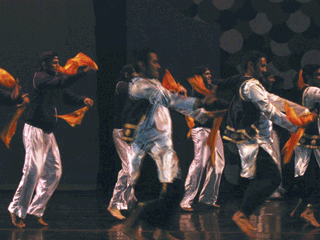
“It’s not too late to change songs,” Shalin Patel quips over the rapid-fire beat of a dhol drum pulsing out of two small iPod speakers. He watches as his teammates hesitate in executing a difficult dance maneuver, their arms pumping in synchrony with shuffling feet. One hour remains before the curtains go up on PhillyFest 2006—a national college competition celebrating the rich curry of styles that make up South Asian desi dance. Tonight, we are at the Annenberg Center—in the fluorescently lit dressing room of Penn’s dance troupe, Dhamaka.
Inside, sequined vests hang from a metal rod and an oversized hoagie sits limp and half-eaten. Bottles of Gatorade line a clunky wooden table. The men of Dhamaka (D-Mak, for short) have practiced endlessly, and are poised to place.
As a third-year medical student at Penn, Shalin has a lot on his mind: “Boards for one thing,” he tells me. The dark circles under his eyes suggest he is tired. It is understandable. Before a competition like this one, Dhamaka averages six-to-eight hours of intense dance practice a day. There are choreographies to be created, dance-steps to be learned, and music to be artfully remixed and cut.
But for Shalin, dressed in his black team hoodie and track pants, the hours of effort are well worth it. “I actually find this energizing,” he says. Tonight, he and the dozen other members of D-Mak will be performing alongside nine collegiate teams—some from as far away as San Diego.
In the hallway outside one can hear payals—anklets, traditionally made of silver—jingling as young men struggle to fold into the fabric of their outfits. Music mixes with shrill exclamations of “Someone help me with my makeup!” and “Who has the safety pins?” This night is about dance, and much more. As Aniket “Ketu” Shah W’06 tells me, brotherhood is at Dhamaka’s core, “but on a larger scale, it’s also about preserving our culture.”
Indeed, competitions like PhillyFest are often very effective at highlighting the cultural richness of South Asian America. Groups like D-Mak are far less interested in featuring the dance traditions of the desh, or country, their parents left behind some years ago. Instead, through a smart, purposeful mixing of sartorial styles and fluid moves, they help define, then showcase, what it means to be a hip desi American youth today.
When the lights dim inside the Zellerbach Theater, the mayhem begins. Equipped with what sounds like a giant cowbell, fans from Pennsylvania State University start chanting encouragement for their team, Jawani: “We aaaare Penn State! Ja-waa-niii!” New York University follows suit with synchronized, almost militant repetitions of “Enn-Whyy-Yoouuu” and, appropriately, “Pandemonium”—the name of their all-male troupe. Dhamaka alumni are not to be outdone: “Whose house?” they bark at the home crowd and receive a bellowing “D-MAK!” in response.
Sitting next to me on the edges of the Penn supporters’ section are Drs. Manoj and Mira Shah. They have made the four-plus hour drive from Albany, New York, to see their son, Dhamaka president Manjool Shah C’06 compete one last time before his May graduation. As the chants assume a new urgency, they begin to sound like battle cries. Between the whistles, loud claps, and ground-shaking stomps, Manoj Shah leans over and says with a grin, “This is the fun part.”
For the three hours that follow, the audience maintains its impassioned high energy. One team after another slides and leaps across the stage. Missy Eliot tracks blend seamlessly with the fast beats of “Naach Baliye,” a song from a popular Bollywood film. The young men of Pandemonium exude machismo in their baggy urban athletic gear—gear they ultimately rip off mid-song to reveal matching dhotis, the traditional garb symbolizing how American and desi identities can be layered brilliantly.
There are exercises in limber athleticism and awesome examples of over-the-top showmanship. When UCLA’s co-ed team Nashaa takes the stage, we are captivated by the storyline and electric blue sequined outfits—all of which would put Bollywood to shame. Members of the Rutgers team jump out of a giant box covered in shiny fabric like Jessica Simpson from a birthday cake.
Respect, an ostentatious trophy, and split of $5,000 in prizes await the top three teams. The judges deliberate. The performers line up on stage. All burst into fevered, rhythmic chants. The din lifts and swells to fill the high ceilings of the auditorium.
When Dhamaka is announced as the third-place winner, the Shahs and I leap to our feet, joined by a raucous home crowd of supporters. The Rutgers team places second. A bit unexpectedly, the University of California, San Diego underdogs are awarded the reigning title. For the other teams, lingering awkwardly on stage and blinking into the blinding lights, the disappointment is clear. Yet for them, one consolation remains: there is always next year.
—Hilal Nakiboglu Isler Gr’05




